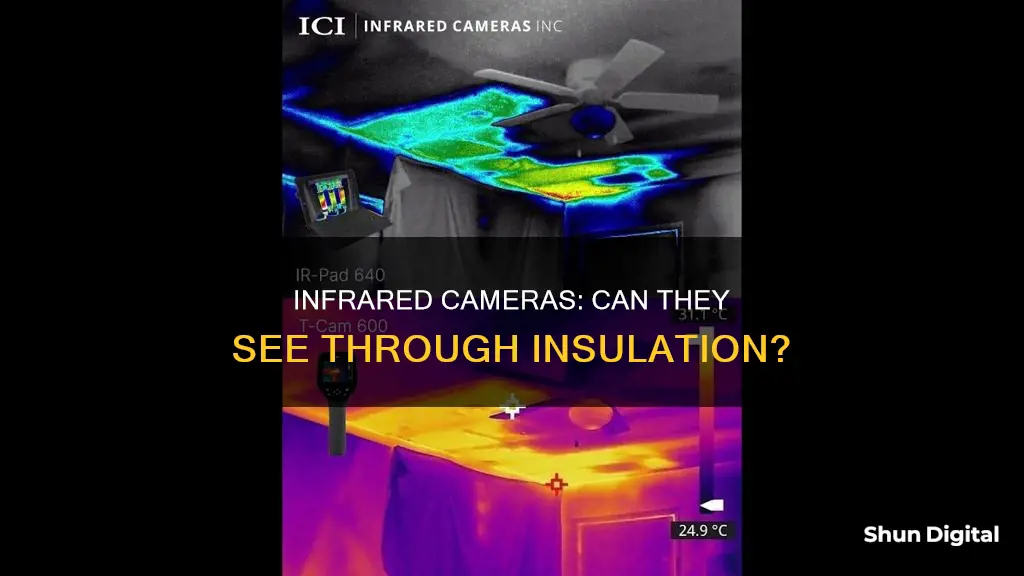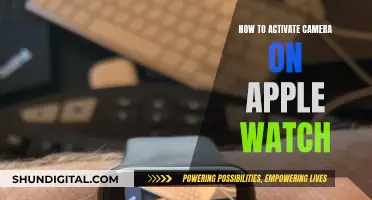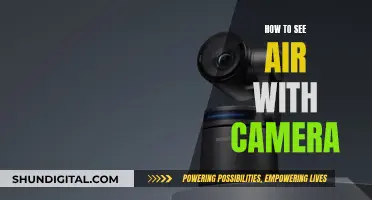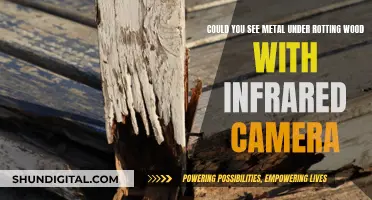
Thermal imaging cameras are an invaluable tool for inspectors, allowing them to identify defects that may not be apparent to the naked eye. They can be used to detect issues such as water leaks, missing insulation, electrical hotspots, and air leaks. While thermal cameras cannot see through walls or solid objects, they can detect temperature differences on the surface of walls caused by studs or insulation defects. By interpreting thermal images, inspectors can identify areas of missing or inadequate insulation. Therefore, IR cameras can be a useful tool to identify areas where insulation needs to be improved, helping to reduce heat loss and improve energy efficiency.
| Characteristics | Values |
|---|---|
| Can IR cameras see through insulation? | No, but they can detect temperature differences on the surface of the insulation. |
| How do IR cameras work? | IR cameras detect infrared radiation or heat in the environment and convert it into a visual image or video. |
| What can IR cameras see? | IR cameras can see hidden water leaks, approaching animals, electrical hotspots, missing insulation, and human footsteps. |
| How to use an IR camera to check for missing insulation | Achieve a temperature difference of at least 15-20 degrees, then use the IR camera to look for temperature differences on walls or ceilings, which indicate missing insulation. |
What You'll Learn

IR cameras can detect insulation defects
IR cameras, also known as thermal cameras, are a powerful tool for inspectors to visualise temperature variations and identify areas where insulation may be lacking. They do this by capturing and interpreting infrared radiation emitted by objects, providing a visual representation of temperature differences. This allows inspectors to identify areas of heat transfer, revealing potential insulation gaps that may have otherwise gone unnoticed.
Thermal imaging cameras are highly effective at detecting insulation defects. They can identify missing or damaged insulation behind walls, which can be a significant issue in homes. Small sections of missing insulation can lead to higher energy bills and even physical damage to the building over time due to issues like mould or ice dams. By scanning walls, ceilings, and other surfaces, inspectors can quickly locate areas requiring further investigation.
Infrared cameras are particularly useful for detecting defects in attic and roof spaces, which are crucial for maintaining a home's energy efficiency. They can also identify inadequate insulation around doors and windows, leading to drafts and energy inefficiency. Electrical outlets are another common area of concern, as they can be sources of air leakage.
To ensure accurate results, inspectors should create specific conditions during the inspection. This includes maintaining a temperature differential of at least 20°F between the inside and outside of the building and avoiding direct sunlight or drafts that may interfere with thermal patterns. Inspectors should also remove any obstructions, such as furniture or clutter, that could block the camera's line of sight.
Visio Quantum 65 Smart TV: Camera Included?
You may want to see also

They can't see through walls
Thermal imaging cameras are an invaluable tool for home inspectors and industrial processes. They can be used to identify hidden problems, such as water leaks, missing insulation, electrical hotspots, and air leaks. However, it's important to note that these cameras have limitations and cannot see through walls.
Thermal cameras do not have X-ray vision and cannot see through solid objects like walls. They detect and visualise heat patterns, temperature changes, and thermal irregularities that may indicate issues such as leaks, blockages, or breaks in insulation. While they can detect temperature differences on the surface of a wall, they cannot see through the wall itself.
The effectiveness of thermal imaging cameras in detecting issues depends on various factors. For example, the total depth a thermal camera can see is limited, and the type of material being inspected plays a significant role. Materials like concrete have low emissivity, meaning they don't efficiently emit the infrared radiation that thermal cameras capture. As a result, thermal cameras might not provide clear insights when scanning through concrete walls.
To enhance the accuracy of thermal imaging, building maintenance professionals often refer to building plans that indicate the locations of internal elements. This helps in interpreting the thermal images and identifying potential issues. Additionally, creating a temperature difference between the interior and exterior of a building can assist in detecting insulation defects and air leaks.
In summary, while thermal imaging cameras are extremely useful for various applications, they cannot see through walls. They detect and visualise heat patterns, helping professionals identify and address issues without the need for destructive testing or tearing down walls.
Is the OLED65C8P TV Watching You?
You may want to see also

They can detect heat through smoke
Thermal cameras can see through smoke to a certain extent, but their effectiveness depends on various factors. They can be extremely useful in situations where smoke is present, such as in firefighting, search and rescue operations, and patrol.
Thermal cameras work by detecting heat signatures and capturing the infrared radiation emitted by objects with a temperature above absolute zero. This radiation has longer wavelengths than visible light, allowing it to penetrate through smoke. Smoke is composed of tiny particles that scatter infrared radiation, enabling thermal cameras to detect objects obscured by smoke. However, the thicker the smoke, the less effective thermal imaging becomes. This is because smoke particles absorb and scatter the infrared radiation, reducing the amount that reaches the camera.
In firefighting scenarios, thermal cameras can be invaluable for locating individuals trapped inside smoke-filled buildings. They can detect the heat signatures of the human body, even through thick smoke, and create an image of the body's heat signature. Additionally, thermal cameras can identify hot spots or smoldering fires that may not be visible to the naked eye, helping firefighters direct their efforts and prevent the fire from spreading.
The distance between the thermal camera and the smoke also impacts its effectiveness. The closer the camera is to the smoke, the better it will be able to see through it. Weather conditions can play a role too; smoke scatters more infrared radiation in humid and windy conditions, making it harder for thermal cameras to see through.
While thermal cameras cannot "see" through solid objects like walls or concrete, they can detect heat signatures that transmit from internal elements through barriers. For example, they can identify hot or cold pipes within a wall or detect heat patterns from wires, ducts, and structural components. This makes them useful for building diagnostics, such as finding missing insulation, air leaks, or moisture damage.
In summary, thermal cameras can detect heat through smoke, but their effectiveness is limited by factors such as smoke thickness, object temperature, and camera sensitivity. They are valuable tools in various industries, including firefighting, rescue operations, and building inspections, where they provide unique insights and enhance safety measures.
Hooking up a Camera to TV: No DVR Needed
You may want to see also

They can be used to find missing insulation
Infrared (IR) cameras are becoming an indispensable tool for home inspectors. They can be used to find missing insulation by reading the thermal images produced by an infrared camera during an inspection, which allows for the quick and accurate identification of defects that may not be immediately apparent to the naked eye.
Infrared imaging is especially useful when looking for insulation defects during an energy audit because it allows the inspector to view the apparent temperatures in a given area. IR cameras can detect light within the heat spectrum that exists just beyond the spectrum that can be seen with the naked eye. Differing heat signatures are displayed in the camera's viewfinder as a gradient colour scheme, with hotter areas displayed as brighter colours and cooler areas as darker colours.
To find missing insulation, an inspector will want to achieve a temperature difference of at least 20 degrees between the interior and exterior of a house. This can be done by heating the house up on a cold day or turning on the air conditioning on a hot day. All windows and exterior doors should be closed during testing. Once a temperature difference has been established, the inspector can use the IR camera to identify hot and cold spots, which may indicate missing or inadequate insulation. Common areas where missing insulation is likely to be found include the space around outlets and switches, the edges of attics, and unfinished garages.
While IR cameras can be expensive to purchase, they can also be rented for a relatively low cost. Alternatively, some electric companies offer free in-home energy surveys that may include the use of IR cameras to detect insulation issues.
Employee Surveillance: Is It Legal?
You may want to see also

They can be used to check insulation on exterior walls
Thermal imaging cameras are an effective tool for checking insulation on exterior walls. They can identify areas of missing or inadequate insulation, which can cause difficulties in maintaining a comfortable indoor temperature and result in higher energy bills.
Thermal imaging cameras, also known as infrared cameras, do not directly see through insulation. Instead, they detect and interpret infrared radiation emitted by objects, providing a visual representation of temperature differences. This technology allows inspectors to identify areas of heat transfer, indicating potential gaps or voids in the insulation.
To prepare for an exterior wall inspection using a thermal imaging camera, it is essential to create a significant temperature difference between the interior and exterior of the house. This can be achieved by heating or cooling the house, depending on the season. Achieving a temperature differential of at least 15° to 20°F between the inside and outside air temperatures is ideal for optimal results.
Once the temperature differential is established, the thermal imaging camera can identify hot and cold spots on the exterior walls, indicating potential insulation issues. Inspectors can then examine these areas to verify the problem and determine the necessary repairs.
It is important to note that factors such as wall coverings or exterior cladding may impact the accuracy of the thermal imaging results. Therefore, inspectors should be aware of these limitations and take various factors into account to obtain the most accurate readings.
By utilizing thermal imaging technology, inspectors can quickly and non-invasively identify insulation defects in exterior walls, providing valuable insights for improving energy efficiency and enhancing indoor comfort.
Unexplained: Caught on Camera' Streaming Options Explained
You may want to see also
Frequently asked questions
No, IR cameras cannot see through insulation. However, they can detect issues like water leaks or missing insulation without needing to tear down walls to assess the problem.
IR cameras detect the invisible world of infrared waves or 'heat' that is radiated by the environment. They detect the unique infrared radiation signature that all objects emit proportional to their temperature.
IR cameras can help find air leaks, water leaks, electrical hotspots, missing insulation, and even human footsteps. They are also useful for inspecting attics and exterior walls to check for missing or inadequate insulation.
Some important factors to consider include the resolution or pixel count, refresh rate, temperature range, camera modes, display quality, connectivity options, reporting and editing software, and battery life.







